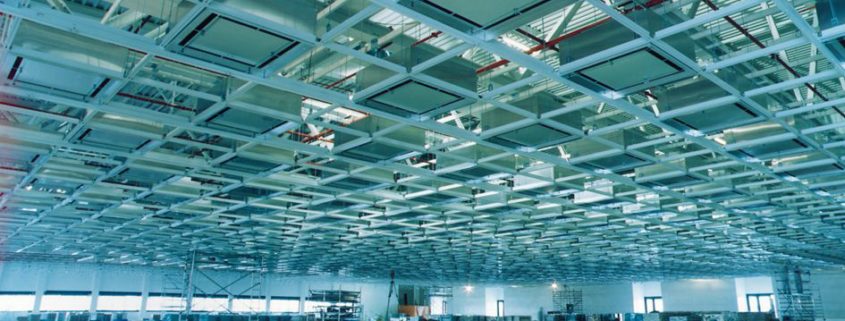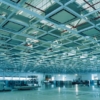Air Filtration and Filtering In Cleanrooms – Part 1
HVAC SYSTEM DESIGN FOR CLEAN FACILITY
HVAC systems in cleanrooms are dramatically different from their counterparts in commercial buildings in terms of equipment design, system requirements, reliability, size and scale.
What differentiates cleanroom HVAC from conventional systems?
Cleanroom design encompasses much more than conventional temperature and humidity control. Typical office building air contains from 500,000 to 1,000,000 particles (0.5 microns or larger) per cubic foot of air. A Class 100 cleanroom is designed to never allow more than 100 particles (0.5 microns or larger) per cubic foot of air. Class 1000 and Class 10,000 cleanrooms are designed to limit particles to 1000 and 10,000 respectively. Reducing the number of particles present in a cleanroom to meet one of these classes can be very complicated. Conditioning air for a cleanroom differs from a normal comfort air conditioned space , in the following ways.
1. Increased Air Supply: Whereas comfort air conditioning would require about 2-10 air changes/hr, a typical cleanroom would typically require 20 – 60 air changes and could be as high as 600 for absolute cleanliness. The large air supply is mainly provided to eliminate the settling of the particulate and dilute contamination produced in the room to an acceptable concentration level.
2. The use of high efficiency filters: The use of high efficiency particulate air (HEPA) filters having filtration efficiency of 99.97% down to 0.3 microns is another distinguishing feature of cleanrooms. The HEPA filters for stringent cleanrooms are normally located at the terminal end and in most cases provide 100% ceiling coverage.
3. Room pressurization: The cleanroom is positively pressurized (to 0.05 in-wc) with respect to the adjacent areas. This is done by supplying more air and extracting less air from the room than is supplied to it.
There is much more into the design of cleanrooms in terms of details of technology of equipment, the type of filtration, efficiency, airflow distribution, amount of pressurization, redundancy, noise issues, energy conservation etc…etc…
FILTRATION SYSTEM
Any air introduced in the controlled zone needs to be filtered. Air filtration involves the separation of “particles” from airstreams. Their removal method is almost as diverse as the size ranges of the particulates generated. Understanding separation techniques requires an exact definition of what particles are. As particles become very small, they cease to behave so much like particles as they do gas phase molecules. It is difficult to tell whether such small particles are actually suspended in air (particles) or diffused throughout it (gas or vapor). The bottom boundary where particles act as true particles is about 0.01 micron. The normal theory of separation does not apply to particles below this size and removing them from air requires techniques reserved for gaseous materials. Particles above 0.01 micron are usually considered to be filterable.
All air entering a cleanroom must be treated by one or more filters. High-efficiency particulate air (HEPA) and ultra-low penetration air (ULPA) filters are the most common filters used in cleanroom applications.
Air filters are constructed of filter media, sealants, a frame, and sometimes a faceguard and/or gasket.
1) Media is the filtering material. Common types of media include glass fiber, synthetic fiber, non-woven fiber, and PTFE. High efficiency filters use sub-micron glass fiber media housed in an aluminum framework.
2) Sealant is the adhesive material that creates a leak-proof seal between the filter media and the frame.
3) Frame is where the filter media is inserted. It can be made from a variety of materials including aluminum, stainless steel, plastic or wood.
4) Faceguard is a screen attached to the filter to protect the filter media during handling and installation.
5) Gasket is a rubber or sponge like material used to prevent air leaks between the filter and its housing by compressing the two together.
Air enters the filter through the upstream side. It flows through the filter, contaminants are taken out of the air, and the ‘clean’ air exits through the downstream side. How
‘clean’ the air is on the downstream side depends on the efficiency of the filter.
Filtration Principles
Filtration of particles relies on four main principles: (1) inertial impaction, (2) interception, (3) diffusion, and (4) electrostatic attraction. The first three of these mechanisms apply mainly to mechanical filters and are influenced by particle size.
1) Impaction occurs when a particle traveling in the air stream deviates from the air stream (due to particle inertia) and collides with a fiber. Generally impaction filters can only satisfactorily collect particles above 10 microns in size and therefore are used only as pre-filters in multi-stage filtration systems. The higher the velocity of air stream, the greater is the energy imparted to the particles and greater is the effectiveness of the principle of impaction.
2) Interception occurs when a large particle, because of its size, collides with a fiber in the filter that the air stream is passing through. In this method, particles are small enough to follow the air stream. The particles come in contact with the fibers and remain “stuck” to the fibers because of a weak molecular connection known as ‘Van- der-Waals’ Forces.
3) Diffusion occurs when the random (Brownian) motion of a particle causes that particle to contact a fiber. Diffusion works with very small particles and works in HEPA and ULPA filters. The particles are so small that they move in a random motion causing the particle to acquire a vibration mode. Because of this vibration mode, the particles have a good chance of coming in contact with the fibers. The smaller the particle, the stronger this effect is. For large particles, over one micron in diameter, this filtration mechanism has virtually no effect.
In the order list above, the most critical areas lie between interception and diffusion. Impaction and interception are the dominant collection mechanisms for particles larger than 1 µm, and diffusion is dominant for particles smaller than 1 µm.
4) Electrostatic attraction, the fourth mechanism, plays a very minor role in mechanical filtration. If a charged particle passes through an electrostatic field, it is attracted to an oppositely charged body. Such charges can be generated and imparted to particles in an airstream in much the same way as static charges develop during the combing of one’s hair or just walking across a rug.
The typical electrostatic air filter is made from polyester or polypropylene strands that are supposedly charged as the air passes through them. Whether particle charges are induced by applying energy to a dirty airstream or occur naturally, they can be valuable tools in increasing air cleaning effectiveness.



